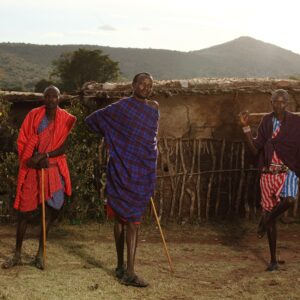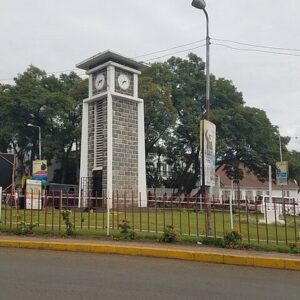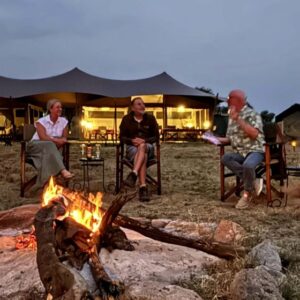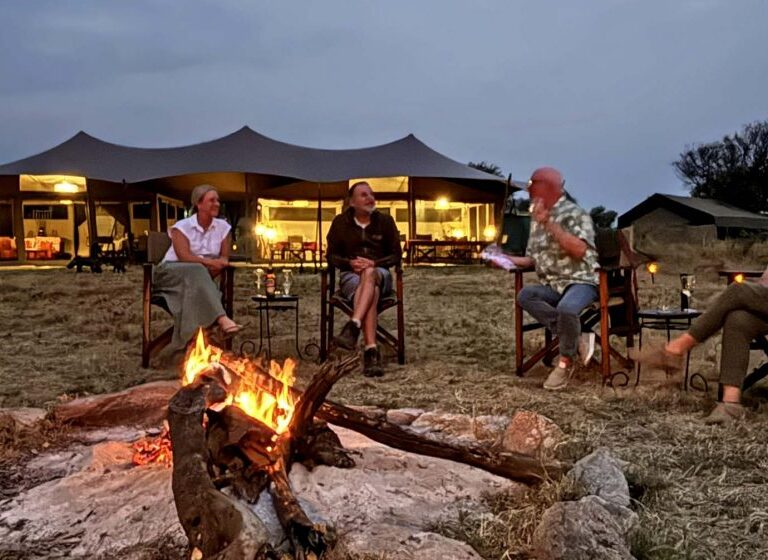Mount Kilimanjaro was formed by volcanic activity beginning about 3 million years ago, a process triggered by tectonic plate movement along the East African Rift. This caused molten rock (magma) to rise and create three distinct volcanic cones: Shira, Mawenzi, and Kibo. Over time, repeated eruptions built up these cones into a single, massive stratovolcano, with Kibo, the youngest and highest, holding Africa’s tallest peak, Uhuru Peak. Standing proudly on the plains of Tanzania, Mount Kilimanjaro is not just Africa’s highest peak; it’s a monumental testament to the powerful, slow-motion ballet of geology. Its snow-capped summit, a beacon for climbers and a symbol of natural majesty, is the result of millions of years of tectonic forces and volcanic activity. The story of Kilimanjaro’s formation is a dramatic saga, a tale of colossal pressures, fiery eruptions, and the relentless sculpting of a landscape.
Tectonic Activity: The Spark of Creation
The story begins deep within the Earth’s crust, with the very forces that shape our continents. Kilimanjaro’s birth intimately linked to the Great Rift Valley, a massive geological feature that stretches for thousands of kilometers across eastern Africa. This rift is a divergent plate boundary, where the Somali and Nubian tectonic plates are slowly pulling apart. As these plates move, the Earth’s crust thins and stretches, creating deep fractures and fault lines. This “rifting” process creates an ideal pathway for molten rock, or magma, to rise from the planet’s mantle towards the surface. The immense pressures and heat generated by this tectonic activity were the fundamental catalyst for the formation of Kilimanjaro. It was on one of these weak points in the Earth’s crust that the mountain would begin its long, slow ascent.
Magma Rising: The Earth’s Fiery Heart
With the crust fractured and a pathway established, magma began its journey upward. This molten rock, superheated and under immense pressure, is less dense than the surrounding solid rock, allowing it to slowly but surely force its way towards the surface. Over millions of years, vast chambers of magma began to accumulate beneath the Earth’s surface in this region. The rising magma wasn’t a sudden event, but a gradual process of building pressure, like a pot of water slowly coming to a boil. This buildup was the critical precursor to the spectacular eruptions that would follow. Mount Kilimanjaro is a large dormant volcano in Tanzania. It is the highest mountain in Africa and the highest free-standing mountain above sea level in the world, at 5,895 m above sea level and 4,900 m above its plateau base.
Volcanic Eruptions: Building the Foundation
Finally, the immense pressure of the rising magma became too great for the overlying rock to contain. The result was a series of colossal volcanic eruptions. These weren’t single, catastrophic blasts, but rather a long series of events spread over millions of years, starting approximately 2.5 million years ago. Kilimanjaro is actually a composite of three main volcanic cones: Shira, Mawenzi, and Kibo. The oldest of these, Shira, began erupting first, forming a massive shield volcano. Over time, its eruptions waned, and it eventually collapsed, leaving behind a caldera, a large bowl-shaped depression at its summit. Simultaneously, or perhaps shortly after, Mawenzi began its own series of powerful, explosive eruptions. This activity formed a steep, jagged peak, its craggy spires a testament to the viscous, slow-moving lava and explosive ash that defined its formation.
Accumulation and Shaping: The Birth of a Stratovolcano
The final, and most famous, cone to form was Kibo, which is now the summit of Kilimanjaro. Unlike the earlier eruptions of Shira and Mawenzi, Kibo’s formation was a more continuous process. It is a classic stratovolcano, or composite volcano, built up over hundreds of thousands of years by alternating layers of lava, volcanic ash, cinders, and volcanic bombs. The lava from Kibo was more fluid than that of Mawenzi, allowing it to flow farther and build a more symmetrical, cone-shaped peak. The iconic summit crater of Kibo, the final piece of the puzzle, was formed by the last significant volcanic activity. While the mountain is now dormant, the last major eruption occurred approximately 360,000 years ago, and minor activity has continued up to as recently as a few hundred years ago.
The Geologic Features of Mount Kilimanjaro
Mount Kilimanjaro is a dormant stratovolcano with three distinct volcanic cones (Kibo, Mawenzi, and Shira) formed by millions of years of volcanic eruptions, creating a massive structure of layered ash, lava, and volcanic rock such as andesite and basalt. The mountain characterized by its layered volcanic composition, including significant amounts of solidified lava flows, ash, and obsidian, with Shira forming a plateau and Mawenzi a jagged peak, while Kibo is the youngest and highest cone that currently holds its glacial features. Kilimanjaro is a living museum of its own geological history, with features that tell the story of its tumultuous past.
Three Volcanic Cones: The most striking feature is the presence of the three distinct cones: the eroded plateau of Shira, the sharp peaks of Mawenzi, and the majestic, snow-covered summit of Kibo. This triple-peaked structure is what gives Kilimanjaro its unique, massive profile. Read this: Kilimanjaro Shira Plateau: The Volcano That Collapsed on Kilimanjaro
Glacial Features: Though the glaciers are rapidly retreating, they have played a significant role in shaping the mountain’s upper reaches. The deep valleys and U-shaped ridges on Kibo’s flanks are classic examples of glacial erosion, carved by the slow, powerful movement of ice.
Volcanic Ash and Lava Flows: The mountain’s slopes are a mosaic of its eruptive history. Layers of hardened lava flows are visible, particularly on Kibo, while vast deposits of volcanic ash and cinders cover the lower slopes, creating fertile soil.
Ecological Diversity: The diverse geology, coupled with the vast range in altitude, has created a remarkable ecological system. The mountain’s slopes are a series of distinct zones, from the low-lying farmlands to rainforests, moorlands, and the alpine desert, each with its unique flora and fauna. Read this: Discovering the Iconic Landmark of Lava Tower Kilimanjaro
What caused the formation of Mount Kilimanjaro?
The formation was caused by tectonic activity along the Great Rift Valley, which allowed magma to rise from the Earth’s mantle, leading to volcanic eruptions. Mount Kilimanjaro formed from volcanic eruptions caused by the East African Rift tectonic activity over the past 2.5 to 3 million years. The mountain is actually composed of three volcanic cones: Shira (the oldest, now collapsed), Mawenzi (extinct), and Kibo (the highest and a dormant cone). Repeated lava flows and ash deposits built up the massive stratovolcano, with erosion and glaciers shaping its current landscape.
Geology of Mount Kilimanjaro
Mount Kilimanjaro is a dormant volcano, formed by three volcanic cones: Kibo, Mawenzi, and Shira. It’s a stratovolcano, meaning it’s built up from layers of lava flows, ash, and volcanic debris. Kibo, the highest peak, still considered potentially active due to fumarolic activity, while Mawenzi and Shira are extinct. The mountain is part of the East African Rift system, where tectonic activity has played a role in its formation. It’s a massive stratovolcano composed of three distinct volcanic cones: Shira, Mawenzi, and Kibo.
Is Mount Kilimanjaro an active volcano?
No, Mount Kilimanjaro its not considered an active volcano. It is classified as a dormant volcano, meaning it has not erupted recently but could potentially erupt again in the future. While some gas vents (fumaroles) are present near the summit, indicating some residual heat, there are no signs of an imminent eruption. Kibo considered a dormant volcano. While it has not had a major eruption in over 360,000 years, scientists have detected recent fumarolic activity, suggesting a magma chamber still exists beneath the summit.
How was Mount Kilimanjaro formed step by step?
Tectonic rifting created fractures in the Earth’s crust. Magma rose through these fractures. A series of volcanic eruptions over millions of years built up the three cones (Shira, Mawenzi, and Kibo) through layers of lava and ash. Mount Kilimanjaro formed over millions of years from successive volcanic eruptions linked to the East African Rift system, building three distinct cones: Shira, Mawenzi, and Kibo. The oldest cone, Shira, collapsed to form a caldera before Mawenzi emerged, followed by the formation of the highest cone, Kibo. Repeated layers of volcanic ash and hardened lava built up the massive stratovolcano, with erosion and glaciers shaping its final form over time. Explore this: When was Mount Kilimanjaro’s last eruption, and will it erupt again?
What type of volcano is Mount Kilimanjaro?
It is a stratovolcano, also known as a composite volcano, characterized by its steep, conical shape and alternating layers of lava and ash. Mount Kilimanjaro is a stratovolcano, also known as a composite volcano. Its made up of three distinct volcanic cones: Kibo, Mawenzi, and Shira. Among them, Kibo is the highest and the only dormant cone, while Mawenzi and Shira are extinct. Stratovolcanoes characterized by their layered structure, formed from alternating eruptions of lava, ash, and volcanic rocks. Kilimanjaro’s last major eruption occurred over 360,000 years ago, with minor activity around 200 years ago.
When did Mount Kilimanjaro last erupt?
Mount Kilimanjaro last erupted around 360,000 years ago and has been dormant since. However, fumaroles near the summit still release gases like sulfur dioxide and carbon dioxide. Indicating ongoing geological activity, but minor activity and gas emissions have been recorded as recently as a few hundred years ago. Read this: Is Mount Kilimanjaro an Active Volcano?
Where is Mount Kilimanjaro?
Mount Kilimanjaro is located in northeastern Tanzania, near the border with Kenya. Specifically, it’s part of Kilimanjaro National Park, situated south of the border with Kenya and northeast of Arusha National Park. The mountain is approximately 130km from Arusha and about one hour from Kilimanjaro International Airport. Mount Kilimanjaro is located in northeastern Tanzania, near the border with Kenya.
Mount Kilimanjaro eruption 2018: There was no eruption in 2018. While the mountain is dormant, there are occasional reports of seismic activity, but these are not indicative of an imminent eruption. The 2018 reports were likely a misunderstanding of minor seismic tremors or gas emissions.
In conclusion
Mount Kilimanjaro is more than just a mountain; it’s a geological masterpiece, forged by the very processes that shape our planet. Its towering presence is a reminder of the immense power of nature, a story written in stone, ash, and ice over millions of years. Mount Kilimanjaro offers several routes, including Machame, Marangu, Lemosho, and Rongai, each varying in scenery, difficulty, and duration. Reviews often highlight Lemosho and Machame for beauty and higher success rates. Reputable tour companies like Foot Slopes Tours and Safaris provide guided packages, with success rates up to 95% on longer routes. Prices range from $2,500 to $5,000, depending on services. Maps and detailed itineraries are provided by operators. Key facts: it’s Africa’s highest peak, non-technical, and requires no climbing experience.








